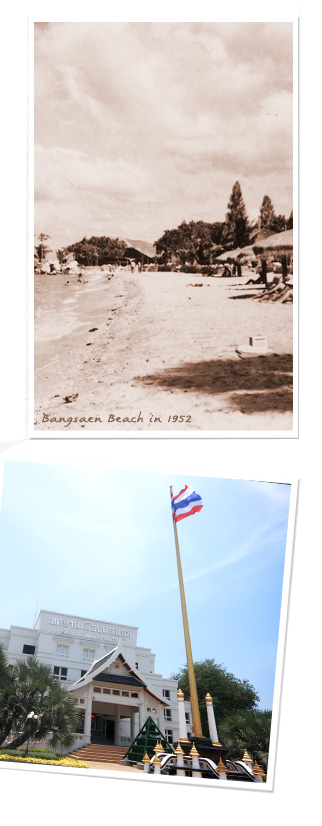
Bangsaen has been a famous beach destination for both Thai and international visitors. In 1943, Not many people knew Saensuk, except the Sam Muk Mountain community, which consisted of only 3-4 households during King Rama V. Community members were fishermen. The Sam Muk Mountain community, at that time, looked like an island located on seashore. In the middle of the mountain had tropical rain forests. Lots of monkeys and snakes could be found. A reputable house shrine was located on the west side. The Sam Muk Moutain community became developed when Field Marshal P.Pibulsongkram built his weekend house on the west side of the mountain during 1943-1945. He also built houses for government important guests from abroad, housesforgovernment officials and roads from Bangsaen to Sam Muk Mountain.
In 1960, Field Marshal Sarit Thanarat built new houses for governmental purposes at Laemtaen (the southwest of the Sam Muk Mountain). Government meetings were often held there. Previous government houses in the Sam Muk Mountain were abandoned ultimately.

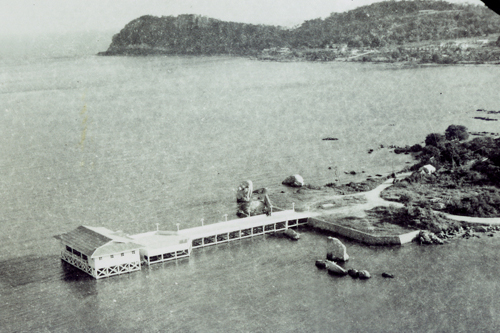
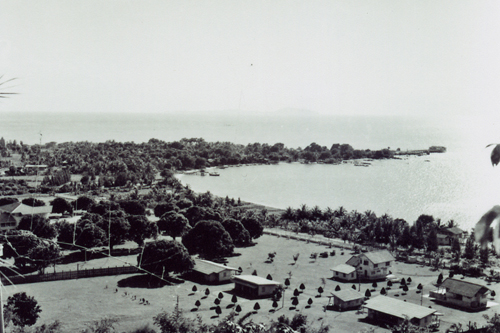
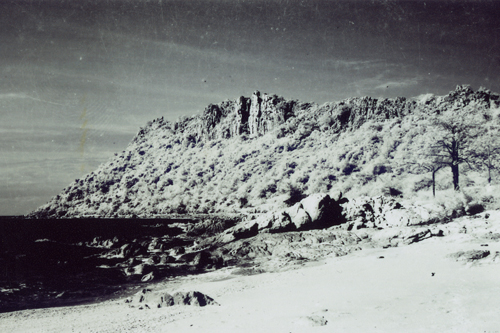
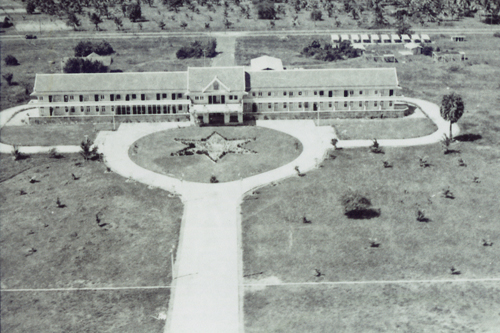
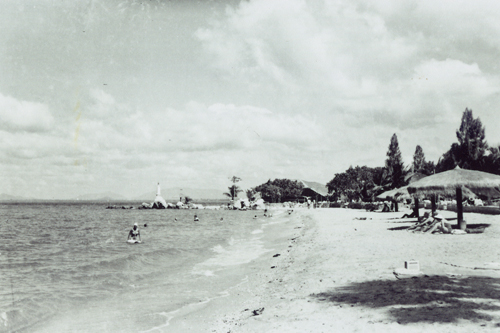
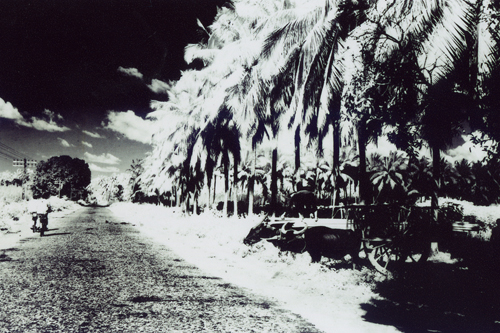
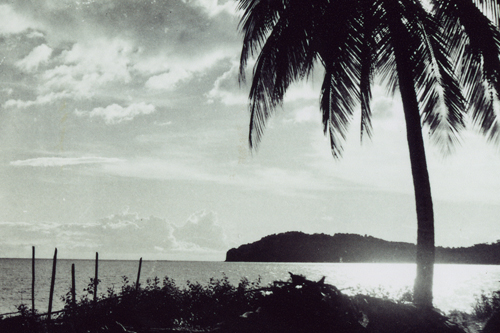
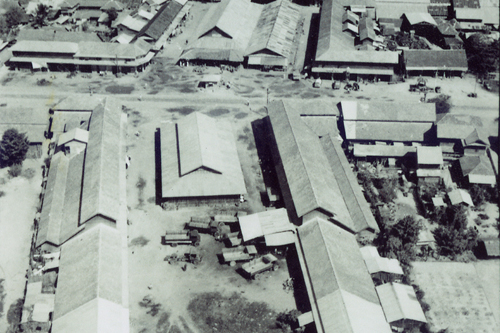
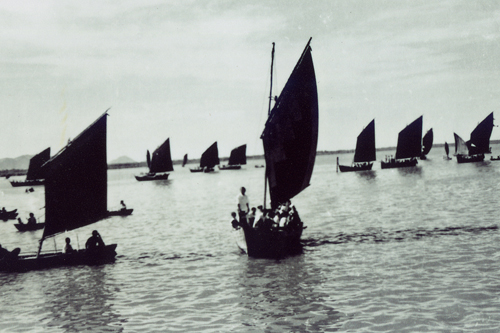
The Saensuk Sub-district Municipality, local administration organization, was renamed in November 26, 1988 chaired by Somchai Kunpluem. Its area was enlarged from 2.5 square kilometers (15 villages) to 20.268 square kilometers (20 villagers). Due to capabilities of the municipality as well as the mayor, development was brought to the Saensuk Sub-district Municipality. In 1993, it was awarded as a “tourist destination city” and received financial supports from different organizations such as Tourism Authority of Thailand, Ministry of Science and Technology, Chonburi Provincial Administration Organization, Department of Provincial Administration and etc. The Saensuk Sub-district Municipality spent money to deliver consistent development.
In October 27, 2001, The Saensuk Sub-district Municipality was renamed to the “Saensuk Municipality”. Its strategy is, “Saensuk Municipality must be a pleasant townto live. Natural resources must be well preserved. Tourist attractions must be clean and known internationally in order to develop its local economy and bring prosperity to local people”.
Until today, the Saensuk Municipality is reputable for its management. It quickly enhances development in most areas and improves some poor communities to meet its standard for tourism. It also boosts up local economy that people earn income all year round.
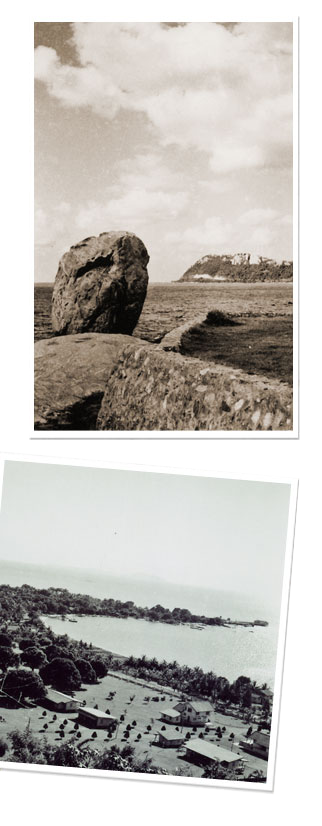
Bangsaen has been a famous beach destination for both Thai and international visitors. In 1943, Not many people knew Saensuk, except the Sam Muk Mountain community, which consisted of only 3-4 households during King Rama V. Community members were fishermen. The Sam Muk Mountain community, at that time, looked like an island located on seashore. In the middle of the mountain had tropical rain forests. Lots of monkeys and snakes could be found. A reputable house shrine was located on the west side. The Sam Muk Moutain community became developed when Field Marshal P.Pibulsongkram built his weekend house on the west side of the mountain during 1943-1945. He also built houses for government important guests from abroad, housesforgovernment officials and roads from Bangsaen to Sam Muk Mountain.
In 1960, Field Marshal Sarit Thanarat built new houses for governmental purposes at Laemtaen (the southwest of the Sam Muk Mountain). Government meetings were often held there. Previous government houses in the Sam Muk Mountain were abandoned ultimately.
It is located at the South of Laemtaen community, the area is mostly a sand beach stretch from Laemtaen, Bang Ptra district for around 5km. Going back 50 to 60 years there were less than 20 houses and families and most of time do fishing for their business. The tool used for fishing at that time was just a small boat that can travel as far as Sri Chang Island. They will only fish to an amount that is enough for their families to consume but if it exceeds then fishes will be taken to sell at Nong Mon market. In the year 1947 some families shift their business from fishing to constructing boat for tourist, however fishing is still the most popular business for a very long time until the period where oil prices increase so people started to do other business like opening hotels and guesthouse. Until now, Bangsaen has had a very rapid growth, the area has been developed systematically and there are clear-cut plans by Saensuk city Authority. It has been determined that this is a tourism places and Saensuk city Authority has first started to reshape the land by moving local people from the coast of the beach to a new residential place.
After that they separated the city into different zones such as relaxation zone, beach zone, water sports zone, souvenir selling, foods, walkways, bicycle path, and parking. With all this, one of the factors that have to be taken into all zones is an Environmental Friendly atmosphere and securities need to be tighten up. Local retailers are being adapted to attract foreigners as well. After dealing with all the process mentioned, the views and sceneries of Bangsaen has been changed by growing a coconut tree along the coast of the beach and it became one of the sculpture of Bansaen beach today.Today, thiscommunity is a very popular tourist attraction and most importantly it helps local people to have income.
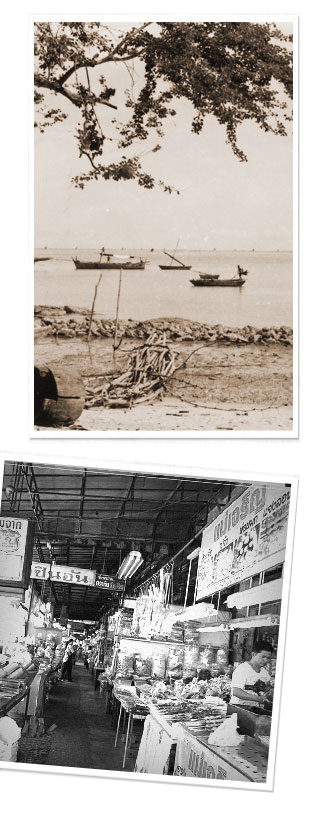
This is a fishing community; the coast of this community is Saem Forest. Going back around 60 to 70 years there were only 4 to 5 families living here and most of them are Thai people and also Thai Chinese. The way of life is simple where they only use a small boat for fishing as to consume and the small houses are made up of thatched rood with some airy space beneath. When time passes, the amount of earning increases and thus making them able to buy a better equipment for fishing and improved size of boat as well and they can now travel further for fishing. Once done they take the fish to sell at the ‘Fish Bridge’ located at Laemtaen, Sam Muk, Ang Sila and Sriracha. Houses and families as been increasing from time to time as people move from Nongmon to live here. Bangkok people likes to come and purchase a seaside house and come to relax on holidays. Around 10 to 20 years back, other than fishing, locals now expand their business from Fishing to making Fish sauce as well as producing dry foods and the return of money is considered to be worth.
In the past it was a small community consisting of both Thai and Chinese people. The floor of the house was built high from the ground, as the basement is use for raising animals. At that time, the business was just a small trading of goods, sometimes they go to acquire goods from Chonburi or even Bangkok to come and sell here. Nongmon Community has started to expand after the Second World War. At the year 1944, there are people from other communities started to flow in and settle at Nongmon. The community started to become famous when Marshal Pibulsonggram has came and built a seaside house at Bangsaen beach as well built roads connection Bangsaen Beachto Sam Muk Mountain. Thus it makes traveling much easier as Nongmon people can use bicycle to travel and trade goods anywhere. The Nongmon market has officially been built in the year 1947 and since then it has expanding rapidly in compliance with the increasing number of tourist. Now the market has expanded to be both sides of Sukhumvit road. The thing that is sold here is mainly foods both fresh and dry as well as souvenirs produce by local people.
The first phase of this community is a Hill, from an assumption this may be a wall or a temple as there as are proof of ancient materials. That’s why the locals this area as ‘Nuen Muang’ or in short ‘Muang’. After the construction of Sukhumvit road connecting Bangkok and Sataheep, Muang community has expanded to this road. It was a birth path in the year 1927 and improved to be a better condition in the year 1947. In the past local people living here does farming as their business but now most of them has sold their farm due to the problem of low income so they shift towards shrimp farming as well as selling products which is processed from heir farm such as stir banana and stir mango.